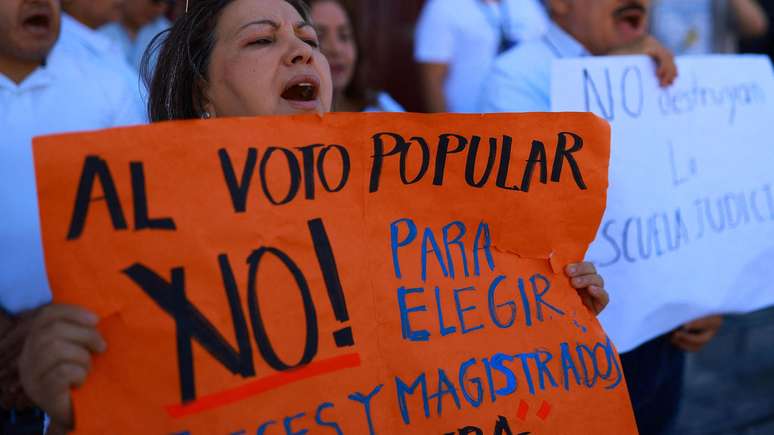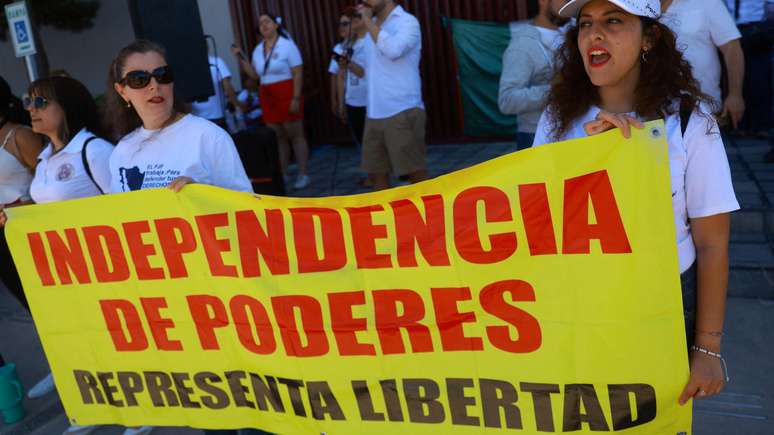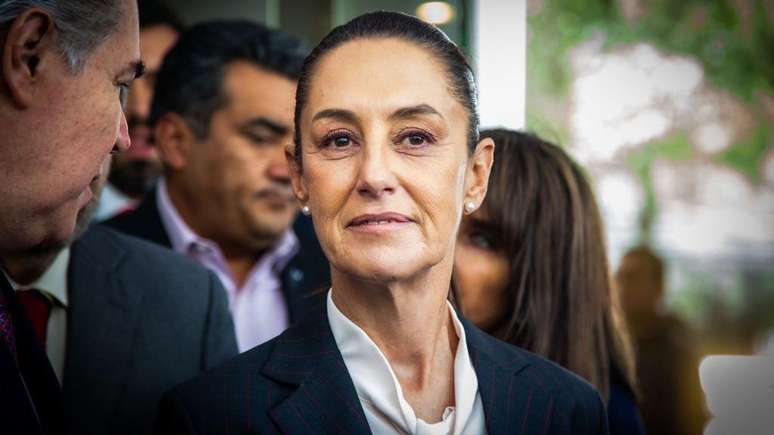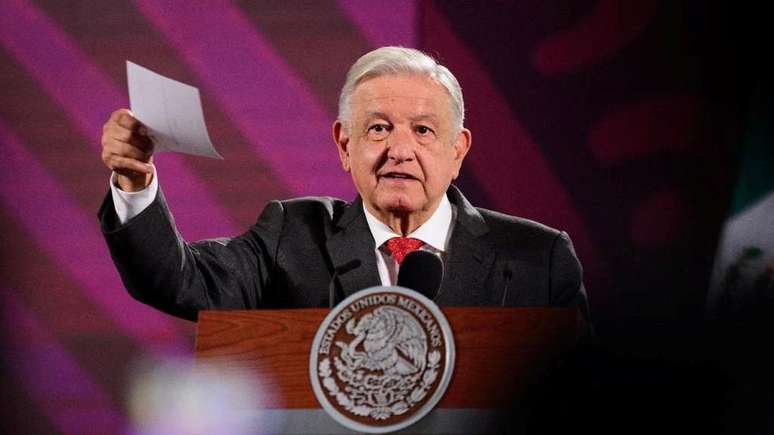Mexico’s controversial judicial reform, considered the most profound change to the judiciary in the last 30 years, is about to receive final approval.
Mexico’s controversial judicial reform – considered the most profound change in the sector in the last 30 years – is very close to becoming a reality.
The Chamber of Deputies approved the reform on Wednesday (9/4). After all, after winning the last elections at the beginning of June, the government has a qualified majority in the Chamber, which allows it to easily approve amendments to the Constitution.
In the coming days, the measures will be discussed in the Senate, where the current government is one seat away from winning two-thirds of the legislature.
The reform is considered a key part of the legacy of President Andrés Manuel López Obrador (known by his initials AMLO). His term expires on October 1, and he will be replaced by President-elect Claudia Sheinbaum.
The bill has received harsh criticism from the opposition and specialized organizations. It was voted in the midst of an unprecedented and indefinite strike by thousands of judges and judicial employees.
Deputies had to vote on the initiative in another building, outside the Legislature, which was blocked by strikers who oppose the project.
Protesters believe the reform undermines the independence of powers and weakens democracy.
The bill was presented to Congress in February. At the time, the Mexican government’s Morena coalition did not yet have enough votes to approve it.
But now, with the new Congress in place, there are no more obstacles to approving the initiative in the House. And in the Senate, although the coalition does not have the same majority, it does not seem difficult to negotiate the single vote needed for approval.
BBC News Mundo, the BBC’s Spanish news service, presents three key points to understand what is changing in Mexico with the historic reform of the judiciary.

1. What is the proposed change?
The most innovative and controversial point of the reform is the election, by popular vote, of almost 2,000 judges and magistrates of the Federal Judiciary, starting next year.
The proposal is that the three powers – executive, legislative and judicial – present lists of candidates for citizens to vote on.
The text establishes that the presidency of the Supreme Court will be renewed every two years, alternately, depending on the number of votes obtained by each candidate in the elections.
In the current system, the 11 judges of the Supreme Court elect its president. And these, in turn, are elected by Congress and appointed by the President of the Republic.
The bill provides for a reduction in the mandate of judges and ministers, as well as a reduction in the number of magistrates in the Supreme Court and the Electoral Court.
It also provides for two elections to renew the positions in the judiciary. The first of these is extraordinary and should be held in June 2025. The second is scheduled for 2027.
The elimination of the life pension for current and future ministers of the Court and the adjustment of their remuneration to the maximum limit established for the President of the Republic are other measures that are part of the project.
On the other hand, the reform creates a disciplinary and administrative body of the Judiciary, independent of the Court. They would deal with matters relating to judicial careers and internal control, in addition to preparing the budget.
The new Judicial Administration Body will consist of five persons, appointed for a period of six years. One of them will be appointed by the Executive, another by the Senate and the other three by the Supreme Court.
This is a reform of the federal judiciary, not of the Mexican judicial system as a whole. It does not affect local systems, nor the prosecutors’ offices, which handle the majority of cases in the country (80%, according to official data).
For this reason, analysts advocate for a specific reform to drive changes at the local level, where most cases of corruption in the judicial system tend to occur.
2. Why it is controversial

Opponents of the amendment argue that electing judges by direct vote at the ballot box will “politicize” justice.
In other words, instead of increasing the independence and transparency of judges, the reform will favor the political selection of candidates, without considering the professional skills of each individual and promotions based on merit.
One of the most frequent criticisms is that the nomination will favor candidates who have a network of contacts, who have funding or political allies from the government.
There is also the fear that the reform will open the door for organized crime to finance candidacies or take advantage of less experienced judges, which in many ways is already happening today.
In a letter to Congress, judges and magistrates warned that the judicial reform does not comply with the rules of the Mexico-United States-Canada Trade Agreement (MEC-T), in aspects such as the commitment to create and maintain “independent systems” and tribunals for the resolution of labor disputes.
Adding to the internal controversy was the warning from the United States Embassy in Mexico, which described the proposal as a “major risk” to democracy, which could jeopardize the trade agreement between the three countries, to be reviewed in 2026.
Among other backlash, the UN Special Rapporteur on the independence of judges and lawyers called for the project to be reconsidered to protect “the independence of the judiciary.”
Human rights organization Human Rights Watch also expressed a similar argument. The proposal, in its opinion, weakens “judicial independence, privacy and accountability.”
Investors have also expressed concern about the reform. They say they fear the next government will have all the tools it needs to implement laws that could harm the business sector, taking away legal certainty for long-term investments or increasing the perception of risk.
Supporters of the reform argue that transforming the judicial system is a way to ensure that the new president can govern without the legal obstacles faced by AMLO to advance his “humanist” agenda.
The current president has repeatedly stated that the courts have become a trench for the opposition, at the service of the most powerful.

3. Why AMLO considers it important for his legacy
During his term, Andrés Manuel López Obrador promoted an ambitious left-wing project, called 4T – the “Fourth Transformation”.
As with Mexican Independence, the Reform and the Revolution of 1910, the project aims to change “the foundations of Mexican society,” according to the government.
In this context, judicial reform appears as an essential movement in the president’s reform agenda. And Claudia Sheinbaum intends to carry these reforms forward.
To boost the Fourth Transformation, AMLO argues that it is necessary to end the “corrupt” power structures that have dominated the country’s leadership for decades, including the judiciary.
According to the president, his goal is to establish a true rule of law, so that judges “are not at the service of a minority”.
AMLO has faced tough battles with the Supreme Court, which has blocked his reforms in the past, one example being a project that expanded state participation in the energy sector.
The government believes that the reform of the judicial system is the cornerstone that will lay the foundation for the implementation of other changes in the country. It therefore considers it one of the fundamental pillars of the 4T project.
The Mexican president has less than a month before leaving office to use the majority obtained with the new legislature and approve his latest projects.
This way, he will be able to sustain his legacy before the next presidential term – which, in Mexico, lasts six years.

Political inspiration
Analysis by Daniel Pardo, BBC News Mundo correspondent in Mexico
What for some is the democratization of justice, for others is its political co-optation. But, regardless of the outcome, it is clear that the inspiration of the reform is political.
In practice, it is intended to limit the powers of the Supreme Court and its ability to create obstacles for the Executive, which during the six years of Andrés Manuel López Obrador’s mandate has seen many of its reforms cut short by judicial arguments.
The reform, in principle, may seem like a way to exploit the popularity of the Morena coalition to gain power. But in the medium term, if popular support were to wane, this could be harmful.
Elections of judges by popular vote are held in two countries on the continent: in the United States (only at the local level) and in Bolivia, where abstention and opposition boycotts have prevented a true democratization of the judicial system.
No one denies that Mexican justice needs reform. It has not changed in years, it has one of the highest rates of impunity, it has inherited the vices of the one-party system and the people do not know or understand it.
Even the election of judges includes only the nominations presented by the Executive. In other words, by definition, it is now politicized.
In any case, experts agree that most of the problems of the judiciary are concentrated where reforms fail to reach: in the prosecutor’s offices and in the regional systems.
Its approval by the Chamber of Deputies without a hitch, but with occasional protests, highlights the rupture that exists between the traditional judicial and political system and the new Mexican majorities of the 4T.
It also seems clear that the opposition emerged from the June elections very fragmented and lacking a narrative, to be able to fight a popular movement like the Morena coalition.
AMLO will govern until the last day as he has done since day one, leaving no one indifferent. The question is how this might affect his successor.
Source: Terra
Rose James is a Gossipify movie and series reviewer known for her in-depth analysis and unique perspective on the latest releases. With a background in film studies, she provides engaging and informative reviews, and keeps readers up to date with industry trends and emerging talents.







